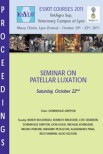With the steady further development of microelectromechanical systems, nowadays, it is possible to measure various specific kinematics of riders with inertial sensors. The aim of the study was to quantify the rider's posture on the horse with a full-body inertial measurement system (Xsens MVN) under field conditions. Ten high-level riders from the German National Equestrian Federation participated in this study. The measurements were performed in sitting trot (ST) in an indoor riding hall. Kinematic data from the riders' segments (head, trunk, and pelvis) and joint angles (elbow and knee) were collected. Qualitative analyses of the waveform parameters and statistical analyses were applied to the data. In addition, the coefficient of multiple correlations (CMCs) was calculated between angle-time courses to quantify the waveform similarities and intertrial repeatability for each rider. All analyzed CMCs ranged from moderate (0.65) to very good (0.92). The two-beat rhythm of the ST was qualitatively represented in the waveform data of the head, trunk, and pelvis about the rotation of the mediolateral axes (Roll). The Roll of the riders' pelvis was significantly greater than the Roll of the riders' trunk. In general, the movements of the riders' segments about the sagittal axes (Pitch) show smaller values than about the mediolateral axes. In conclusion, this setup seems to be suitable to quantify riders' kinematics under certain field conditions. Based on these findings, there is a possibility to obtain several objective information of the riders' kinematics in different equine gaits and skill levels.
Application of a Full Body Inertial Measurement System in Dressage Riding
Date
November-December 2014
Journal
Journal of Equine Veterinary Science
Volume
34
Number
11-12
Pages
1294-1299









